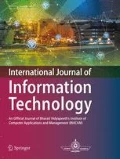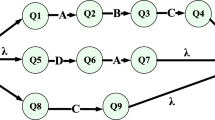Abstract
In this paper a reusable, generalized, parallel DNA computing model is presented to evaluate any logic function at molecular level. The gate strands designed by this algorithm act both as logic operator and sensor to detect the output. Though this model could be employed to simulate vast range of logic functions but for simplicity of explanation theoretical simulation results of DNA based NAND, NOR, half-adder, full-adder and four-bit carry ripple adder are demonstrated to validate this model. The proposed model relies on the induced hairpin formation property of naphthyridine dimer in a G–G mismatched DNA oligo strand which is integrated with a generalized gate design algorithm. Contribution of this work lies in the inclusion of features like single design strategy for any logic function, uniformity in representation of logic 0 and 1 throughout the simulation process and is cost and implementation effective with parallel processing capacity.













Similar content being viewed by others
References
Feynman R (1960) There’s plenty of room at the bottom. Eng Sci 23(5):22–36
Adleman LM (1994) Molecular computation of solutions to combinatorial problems. Science 266(5187):1021–1024
Ogihara M, Ray A (1998) DNA-based self-propagating algorithm for solving bounded-fan-in Boolean circuit. In: Proceedings of the third conference on genetic programming. Morgan Kaufman Publisher, San Francisco, p 725–730
Ogihara M, Ray A (1999) Simulating Boolean circuits on a DNA computers. Algorithmica 25:239–250
Amos M, Dunne P (1997) DNAsimulation of Boolean circuits. Technical report CTAC-97009. Department of Computer Science, University of Liverpool
Erk K (1999) Simulating Boolean circuits by finite splicing. In: Proceedings of the congress on evolutionary computation, vol 2. IEEE Press, New York, p 1279–1285
Mulawka JJ, Wasiewicz P, Plucienniczak A (1999) Another logical molecular NAND gate system. In: Proceedings of the seventh international conference on microelectronics for neural, fuzzy and bio-inspired systems. Granada, Spain, p 340–346
Liu W, Shi X, Zhang S, Liu X, Xu J (2004) A new DNA computing model for the NAND gate based on induced hairpin formation. BioSystems 77:87–92
Liu W, Zhu X, Wang X, Yin Z, Wang S (2008) Simulating the XOR gates based on the induced hairpin formation. Curr Nanosci 4(1):108–110
Smith E, Kyo M, Kumasawa H, Nakatani K, Saito I, Corn RM (2002) Chemically induced hairpin formation in DNA monolayers. J Am Chem Soc 124:6810–6811
Ahrabian H, Ganjtabesh M, Nowzari-Dalini A (2005) DNA algorithm for an unbounded fan-in Boolean circuit. BioSystems 82:52–60
Kadkhoda M, Pouyan AA (2006) A DNA-based simulation model for bounded fan-in Boolean circuits. In: Proceedings of the 10th WSEAS international conference on Computers. World Scientific and Engineering Academy and Society (WSEAS)
Shapiro E, Gil B (2007) Biotechnology: logic goes in vitro. Nat Nanotechnol 2:84–85
Frezza BM, Cockroft SL, Ghadiri MR (2007) Modular multi-level circuits from immobilized DNA-based logic gate. J Am Chem Soc 129:14875
Zoraida BSE, Arock M, Ronald BSM, Ponalagusamy R (2009) A novel generalized design methodology and realization of Boolean operations using DNA. BioSystems 97:146–153
Park KS, Jung C, Park HG (2010) “Illusionary” polymerase activity triggered by metal ions: use for molecular logic-gate operations. Angew Chem Int Ed 49:9757–9760
Goel A, Morteza I (2011) A renewable, modular, and time-responsive DNA circuit. Nat Comput 10:467–485
Genot AJ, Bath J, Turberfield AJ (2011) Reversible logic circuits made of DNA. J Am Chem Soc 133:20080–20083
Li W, Yang Y, Yan H, Liu Y (2013) Three-input majority logic gate and multiple input logic circuit based on DNA strand displacement. Nano Lett 13:2980–2988
Li W, Zhang F, Yan H, Liu Y (2016) DNA based arithmetic function: a half adder based on DNA strand displacement. Nanoscale 8:3775–3784
Boruah K, Deka R,Dutta JC (2018) A model to demonstrate the universality of DNA-NAND gate. In: Advances in electronics, communication and computing. Springer, Singapore, p 67–76
Boruah K, Deka R, Dutta JC (2017) Algorithm to simulate a chemically induced DNA logic gate and Boolean circuit. Curr Trends Biotechnol Pharm 11(2):160–166
Acknowledgements
The authors acknowledge Tezpur University for providing necessary facilities.
Author information
Authors and Affiliations
Corresponding author
Ethics declarations
Conflict of interest
The authors have no conflicts of interest to disclose.
Rights and permissions
About this article
Cite this article
Boruah, K., Dutta, J.C. An improved generalized DNA computing model to simulate logic functions and combinational circuits. Int. j. inf. tecnol. 10, 379–390 (2018). https://doi.org/10.1007/s41870-018-0110-7
Received:
Accepted:
Published:
Issue Date:
DOI: https://doi.org/10.1007/s41870-018-0110-7




